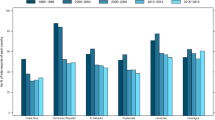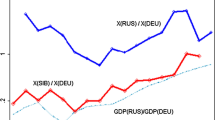Abstract
Between 1955 and 1987, Austrian trade with Eastern Europe was characterized by specific factors. On the one hand, trade flows were influenced by the central planning system in Eastern Europe. On the other hand, Austria applied non-standard policy tools to manage Eastern trade. Furthermore, Austrian trade with Eastern Europe was affected by the implementation of the free trade agreement with the European Communities (EC) and the change in the institutional framework for Eastern trade in the early 1970s. Austrian Eastern exports were fostered by increased export subsidies and barter trade. We assess the net effects of these contradictory measures of trade policy by estimating aggregate import and export equations and testing for a structural break in 1973. Our results are consistent with the view that Austria subsidized Eastern exports to pursue a countercyclical policy after 1973.

Similar content being viewed by others
Notes
In 1948 Moscow denied her satellite states to participate in the Marshall plan. Consequently, in 1949 the CMEA was founded. Founding members were the Soviet Union, Bulgaria, Czechoslovakia, Poland, Romania, and Hungary (see Zwass 1989; Machowski 1986). In subsequent years, Cuba, East Germany, Mongolia and Vietnam joined the CMEA, while Romania stopped participating in CMEA meetings after disputes with the Soviet Union in early 1960s. As a part of the economic transition, the CMEA was officially dissolved in Budapest in June 1991.
Marin and Schnitzer (1998) show that barter and countertrade may be efficient institutions to mitigate contractual hazards which arise in technology trade, marketing and imperfect capital markets.
Fidrmuc (2005) discusses the trade of Eastern Europe after 1990.
The fact that, beginning in the 1970s, these kinds of deals played an essential role in East-West trade for more than two decades confirms Marin and Schnitzer’s proposition (see footnote 2).
Given that the terms of trade affect trade vis-à-vis all countries, we work with the terms of total Austrian trade. Furthermore, country-specific terms of trade are not available for Eastern European countries.
Federal Republic of Germany, France Italy, Netherlands, Switzerland and the United Kingdom.
This result is consistent with Stankowsky (1972) who found that the price elasticities were generally less important in East-West trade than in trade among market economies.
References
Barisitz S (1990) Austria—a business bridge between East and West. Österreichische Osthefte 32:110–117
Breuss F (1983) Österreichs Außenwirtschaft 1945–1982. Signum, Vienna
Brisou S (1988) L’Autriche, plaque tournante des échanges est-ouest. Le Courrier des Pays de l’Est 333:25–38
Bródy A (1992) Gestation lags and the explanation of investment cycles in Socialist economies. In: Hillinger C (ed) Cyclical growth in market and planned economies. Clarendon Press, Oxford, pp 149–155
Butschek F (1998) Statistische Reihen zur österreichischen Wirtschaftsgeschichte. WIFO, Vienna
Combs P (1985) Austria assumes growing role as “middleman”. International Trade: Business America, October 28:10–13
Engle RF, Granger CWJ (1987) Co-integration and error correction: representation, estimation and testing. Econometrica 55:251–276
Fidrmuc J (2005) Trade structure during accession to the EU. Post-Communist Econ 17:225–234
Fidrmuc J, Pichelmann K (1999) Austrian experience of the entrance to the European Union. In: Courbis R, Welfe W (eds) Central and Eastern Europe on its way to European Union. Peter Lang Verlag, Frankfurt am Main, pp 271–293
Fink G, Mauler K (1988) Hard currency position of CMEA countries and Yugoslavia. Sonderdruck der Ersten österreichischen Sparkasse, The Vienna Institute for International Economic Studies, Vienna
Goldmann J (1969) Fluctuations in the growth rate in a Socialist economy and the inventory cycle. In: Bronfenbrenner M (ed) Is the business cycle obsolete? Wiley-Interscience, New York, pp 332–348
Goldmann J, Kouba K (1969) Economic growth in Czechoslovakia. Orbis, Praha
Hillinger C (1992) Paradigm change and scientific method in the study of economic fluctuations. In: Hillinger C (ed) Cyclical growth in market and planned economies. Clarendon Press, Oxford, pp 5–46
Keuschnigg C, Kohler W (1996) Austria in the European Union: dynamic gains from integration and distributional implications. Econ Policy 22:155–211
Kornai J (1980) Economics of shortage, 2 vols. North Holland, Amsterdam
Lenz AJ (1985) Controlling international debt: implications for East-West trade. In: Fink G (ed) Die Ost-West-Wirtschaftsbeziehungen heute und morgen. Springer, Vienna, pp 33–70
Levcik F, Stankovsky J (1985) A profile of Austria’s East-West trade in the 1970s and 1980s. Study prepared for the Economic and Social Council, United Nations
Machowski H (1986) RGW. In: Ziemer K (ed) Sozialistische Systeme, Pipers Wörterbuch zur Politik, 4, Piper, Munich, pp 386–393
MacKinnon JG (1991) Critical values for cointegration tests. In: Engle RF, Granger CWJ (eds) Long-run economic relationships. Oxford University Press, Oxford, pp 267–276
MacKinnon JG (1996) Numerical distribution functions for unit root and cointegration tests. J Appl Econ 11:601–618
Maddison A (2003) The world economy: historical statistics. OECD, Paris
Marin D, Schnitzer M (1998) Economic incentives and international trade. Eur Econ Rev 42:705–716
Oesterreichische Kontrollbank (1981) Export guarantees and export financing in Austria. OeKB, Vienna
Olivera JHG (1960) Cyclical economic growth under collectivism. Kyklos 13:219–255
Perron P (1989) The great crash, the oil price shock, and the unit root hypothesis. Econometrica 57:1361–1401
Pesaran MH, Shin Y (1995) An autoregressive distributed lag modelling approach to cointegration analysis. Working Paper No. 9514, Department of Applied Economics, University of Cambridge
Pesaran MH, Shin Y, Smith RJ (1996) Testing for the existence of a long-run relationship. Working Paper No. 9622, Department of Applied Economics, University of Cambridge
Phillips PCB, Hansen BE (1990) Statistical inference in instrumental variables regression with I(1) processes. Rev Econ Stud 57:99–125
Seidel H (2005) Österreichs Wirtschaft und Wirtschaftspolitik nach dem Zweiten Weltkrieg. Manz, Vienna
Seitz W (1960) Österreichs Aussenhandel mit dem europäischen Osten. Dissertation, Vienna
Stankovsky J (1972) Bestimmungsgründe des Ost-West-Handels. WIFO Monatsberichte, 10/1972:412–424
Stankovsky J (1980) Handels- und Kreditbeziehungen zwischen Ost und West. DFG-Jahrbuch 1979/80, Nomos, Baden-Baden, pp 527–555
Stankovsky J (1983) Bedeutung, Mittelbedarf und Kosten der Exportförderung in Österreich. WIFO Monatsberichte 8/1983:517–528
Stankovsky J (1986) Bedeutung, Probleme und Usancen der Gegengeschäfte. WIFO Monatsberichte 3/1986:157–179
Stankovsky J (1990) Österreichs Osthandel im Umbruch. WIFO Monatsberichte 6/1990:365–377
Stankovsky J (1991) Der neue Osthandel. WIFO Monatsberichte 5/1991:245–255
Stankovsky J (1992) Foreign trade in East-Central Europe and in Austria: Retrospective and Perspective. Working Papers No. 52, WIFO, Vienna
Stankovsky J (1998) Österreichs Osthandel seit der Wende 1989. WIFO Monatsberichte 10/1998:665–678
Szlaifer H (1997) Promise, failure and prospects of economic nationalism in Poland. In: Teichova A (ed) Central Europe in the twentieth century. Ashgate, Aldershot, pp 43–59
Tarjan TG (1992) Macroeconomic fluctuations based on gestation lags: a formal analysis. In: Hillinger C (ed) Cyclical growth in market and planned economies. Clarendon Press, Oxford, pp 157–163
Teichova A (1997) Eastern Europe in transition: economic development during the interwar and postwar period. In: Teichova A (ed) Central Europe in the twentieth century. Ashgate, Aldershot, pp 5–21
Viditz M (2001) Die Handelsbeziehungen Österreichs zu den Mitgliedsländern des RGW unter Einbeziehung des Transithandels. Dissertation, Vienna
Zwass A (1989) The council for mutual economic assistance. Armonk, Sharpe London
Acknowledgments
The authors would like to thank two anonymous referees for helpful comments.
Author information
Authors and Affiliations
Corresponding author
Appendix
Appendix
Rights and permissions
About this article
Cite this article
Fidrmuc, J., Kaufmann, S. & Resch, A. Structural breaks in Austrian foreign trade with Eastern Europe during the early 1970s. Empirica 35, 465–479 (2008). https://doi.org/10.1007/s10663-008-9068-1
Published:
Issue Date:
DOI: https://doi.org/10.1007/s10663-008-9068-1




